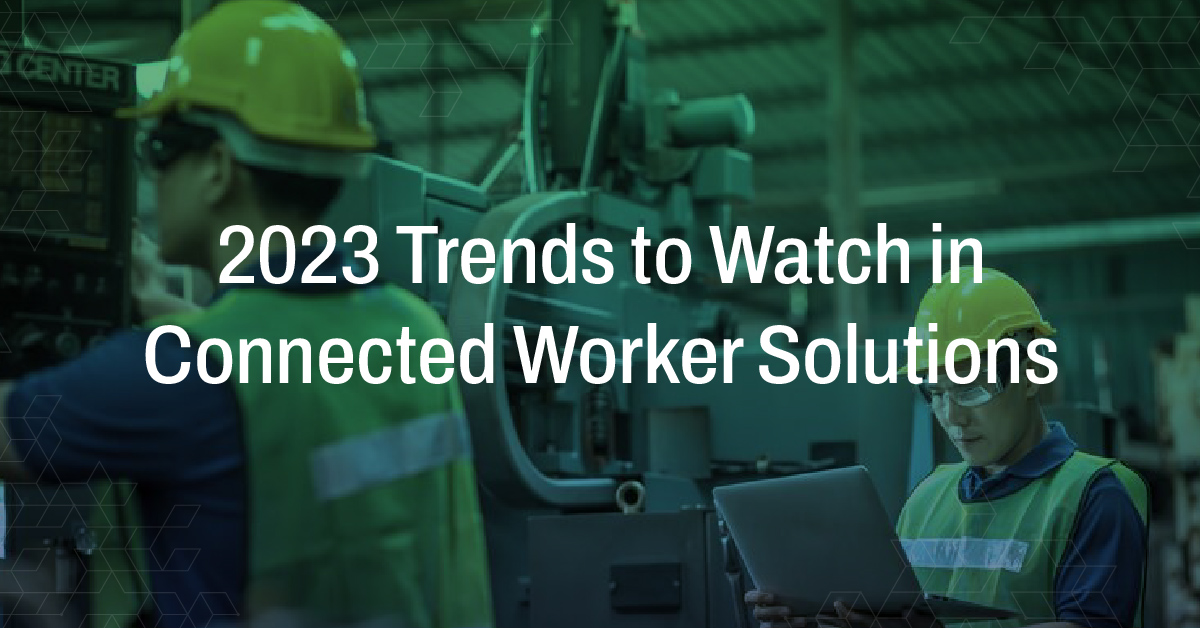As we start the new year, it’s important to keep an eye on the latest trends in connected worker solutions. These technologies are becoming increasingly important for companies looking to improve the efficiency, safety, and communication of their field workers. According to
recent market research, the global connected worker market is expected to reach US$ 23.4 billion by 2029 at a CAGR of 23.2% during the prediction period of 2022-2029. The demand for connected worker technology has increased as more and more companies adopt advanced gadgets and automation. COVID-19 has also played an important role in driving the demand for connected worker solutions. Another key driver for the growth in connected worker technology is the need to have a “safe” environment for workers on the field.
There are multiple factors that affect frontline workers’ productivity, health, and safety. Intelligent hardware and software tools can help in detecting, eradicating, replacing, and controlling occupational hazards to safeguard and promote the health of workers and the overall throughput.
Let’s look at some of the key technology trends that are driving innovative applications and use cases in connected worker solutions.
Sophistication in Wearable Technology
Wearable technology has found numerous use cases in health and fitness applications. However, in the recent past, supply chain digitization and extensive use of smart devices have made wearable technology an important consideration in connected worker solutions.
The use of wearable technology has become a prominent trend in the connected worker industry.
Wearables are equipped with advanced technologies like the Internet of Things (IoT), artificial intelligence, and machine learning that allow for continuous monitoring of workers and their surroundings. This provides context-sensitive data and decision-making assistance, making the work of frontline workers safer, more efficient, and smarter. Hands-free data capture is also possible with the use of voice control, augmented reality, and assisted reality, these technologies can accelerate enterprise digital transformation.
Integration with industrial automation
The integration of
industrial automation is crucial for productivity management, as it enables the sharing of data among employees. With the growing trend of mobile and distributed workforce, it’s important to have access to documents, whitepapers, tools, and platforms, as well as data collected from various sources. This ensures consistency in the way data is collected, presented, and shared. Telepresenz® remote collaboration and workflow management software helps to achieve this by integrating with industrial automation software options, making it possible for manufacturers to give remote workers access to information and optimize data use, regardless of their location.
Convergence of IT and OT
IT stands for information technology and OT stands for operational technology – the backed hardware and software that control and execute processes on the shop floor, mainly in manufacturing use-case. The convergence of these two systems facilitates data exchange which will eventually improve the ability of workers on the shop floor. Telepresenz® plays a role in the convergence of IT and OT by providing solutions that enable the integration of these two systems, offering manufacturers a way to enable remote workers to access information and optimize data use, regardless of their location. The emergence of the Industrial Internet of Things and wireless technology has further facilitated the convergence of IT & OT, reshaping modern manufacturing processes.
Artificial intelligence (AI) and machine learning (ML)
Artificial intelligence (AI) and machine learning (ML) are two key technologies that are also driving innovation in connected worker solutions. As more data is collected from connected worker solutions, companies are using AI and ML to analyze it and make sense of it. This leads to more accurate and actionable insights for companies, which can be used to improve the efficiency and safety of their operations.
AI and ML can be used to analyze data from various sources, such as sensors, cameras, and other connected devices. This data can be used to identify patterns and trends, which can be used to make predictions about future events, such as equipment failures or production bottlenecks. By identifying these potential issues in advance, companies can take proactive measures to prevent them from occurring, which can save time and money in the long run.
Cloud-Based Software
A cloud-based connected worker solution is a technology that allows companies to have real-time visibility, improved collaboration, scalability, cost-effectiveness, security, flexibility, data backup, and data analysis capabilities. This can improve the efficiency and communication of their field workers, leading to more productive and profitable operations. It also allows remote workers to access information and collaborate with other team members, regardless of their location. These solutions are also secure and cost-effective as they typically have lower upfront costs and ongoing maintenance expenses than on-premise solutions, and they also provide data backup, which is important for companies looking to protect their data in case of a disaster.
Final Thoughts
In conclusion, connected worker solutions are becoming increasingly important for companies of all sizes, from small and medium to large enterprises. With the growing concern for employee safety and the need to increase productivity, the connected worker solutions market is expected to see significant growth in the coming years. Companies that invest in these technologies will be better equipped to improve the efficiency, communication, and coordination of their field workers, leading to more productive and profitable operations.


